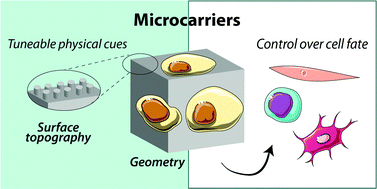Hipster microcarriers: exploring geometrical and topographical cues of non-spherical microcarriers in biomedical applications
Abstract
Structure and organisation are key aspects of the native tissue environment, which ultimately condition cell fate via a myriad of processes, including the activation of mechanotransduction pathways. By modulating the formation of integrin-mediated adhesions and consequently impacting cell contractility, engineered geometrical and topographical cues may be introduced to activate downstream signalling and ultimately control cell morphology, proliferation, and differentiation. Microcarriers appear as attractive vehicles for cell-based tissue engineering strategies aiming to modulate this 3D environment, but also as vehicles for cell-free applications, given the ease in tuning their chemical and physical properties. In this review, geometry and topography are highlighted as two preponderant features in actively regulating interactions between cells and the extracellular matrix. While most studies focus on the 2D environment, we focus on how the incorporation of these strategies in 3D systems could be beneficial. The techniques applied to design 3D microcarriers with unique geometries and surface topographical cues are covered, as well as specific tissue engineering approaches employing these microcarriers. In fact, successfully achieving a functional histoarchitecture may depend on a combination of fine-tuned geometrically shaped microcarriers presenting intricately tailored topographical cues. Lastly, we pinpoint microcarrier geometry as a key player in cell-free biomaterial-based strategies, and its impact on drug release kinetics, the production of steerable microcarriers to target tumour cells, and as protein or antibody biosensors.

- This article is part of the themed collection: Recent Review Articles


 Please wait while we load your content...
Please wait while we load your content...